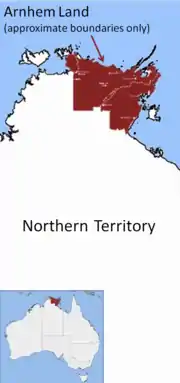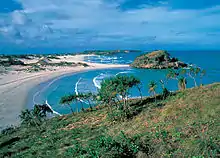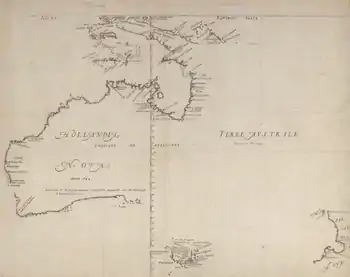Arnhem Land
Arnhem Land is a historical region of the Northern Territory of Australia. It is located in the north-eastern corner of the territory and is around 500 km (310 mi) from the territory capital, Darwin. In 1623, Dutch East India Company captain Willem Joosten van Colster (or Coolsteerdt) sailed into the Gulf of Carpentaria and Cape Arnhem is named after his ship, the Arnhem, which itself was named after the city of Arnhem in the Netherlands.
| Arnhem Land Northern Territory | |
|---|---|
 Approximate location of Arnhem Land | |
| Population | 16,230 (2007)[1] |
| • Density | 0.1673/km2 (0.4334/sq mi) |
| Area | 97,000 km2 (37,451.9 sq mi) |
| Territory electorate(s) | Arafura, Mulka, Arnhem |
| Federal Division(s) | Lingiari |
The area covers about 97,000 square kilometres (37,000 sq mi) and has an estimated population of 16,000, of whom 12,000 are Indigenous Australians. The region's service hub is Nhulunbuy, 600 kilometres (370 mi) east of Darwin, set up in the early 1970s as a mining town (bauxite). Other major population centres are Yirrkala (just outside Nhulunbuy), Gunbalanya (formerly Oenpelli), Ramingining, and Maningrida.
A substantial proportion of the population, which is mostly Aboriginal, lives on small outstations or homelands. This outstation movement started in the early 1980s. Many Aboriginal groups moved to usually very small settlements on their traditional lands, often to escape the problems of the larger towns. These population groups have very little Western influence culturally speaking, and Arnhem Land is arguably one of the last areas in Australia that could be seen as a completely separate country. Many of the region's leaders have called and continue to call for a treaty that would allow the Yolngu to operate under their own traditional laws.
In 2013–14, the entire region contributed around A$1.3 billion or 7% to the Northern Territory's gross state product, mainly through bauxite mining.
In 2019, it was announced that NASA had chosen Arnhem Land as the location for a space launch facility.
History

Arnhem Land has been occupied by Aboriginal peoples for tens of thousands of years and is the location of the oldest-known stone axe, which scholars believe to be 35,500 years old.[2]
Macassan contact
At least since the 18th century (and probably earlier) Muslim traders from Makassar of Sulawesi visited Arnhem Land each year to trade, harvest, and process sea cucumbers or trepang. This marine animal is highly prized in Chinese cuisine, for folk medicine, and as an aphrodisiac.
This Macassan contact with Australia is the first recorded example of interaction between the inhabitants of the Australian continent and their Asian neighbours.[3]
This contact had a major effect on local Aboriginal Australians. The Makassans exchanged goods such as cloth, tobacco, knives, rice, and alcohol for the right to trepang coastal waters and employ local labour. Makassar pidgin became a lingua franca along the north coast among several indigenous Australian groups who were brought into greater contact with each other by the seafaring Makassan culture.[3]
These traders from the southwest corner of Sulawesi also introduced the word balanda for white people, long before western explorers set foot on the coasts of northern Australia. In Arnhem Land, the word is still widely used today to refer to white Australians. The Dutch started settling in Sulawesi Island in the early 17th century.
Archeological remains of Makassar contact, including trepang processing plants (drying, smoking) from the 18th and 19th centuries, are still found at Australian locations such as Port Essington and Groote Eylandt. The Makassans also planted tamarind trees (native to Madagascar and East Africa).[3] After processing, the sea cucumbers were traded by the Makassans to Southern China.
In 2014, an 18th-century Chinese coin was found in the remote area of Wessel Islands off the coast on a beach on Elcho Island during a historical expedition. The coin was found near previously known Macassan trepanger fishing sites where several other Dutch coins have been discovered nearby, but never a Chinese coin. The coin was probably made in Beijing around 1735.[4]
Florida Station
In 1884, 10,000 square miles of Arnhem Land was sold by the colonial British government to cattle grazier, John Arthur Macartney. The property was called Florida Station and Macartney stocked it with cattle overlanded from Queensland. Monsoonal flooding, disease and strong resistance from the local Aboriginal population resulted in Florida Station being abandoned by Macartney in 1893. The first manager of the property, Jim Randell, bolted a swivel cannon to the verandah of the homestead to keep the Indigenous people away, while Jack Watson, the last manager of the property, reportedly "wiped out a lot" of "the blacks" living on the coast at Blue Mud Bay.[5][6][7] During the period of Watson's management, another large massacre is recorded to have happened at Mirki on the north coast of Florida Station. The Yolngu people today remember this massacre where many people including children were shot dead.[8][9]
Eastern and African Cold Storage Supply Company
From 1903 to 1908, the property rights of much of Arnhem Land were held by the Eastern and African Cold Storage Supply Company. This Anglo-Australian consortium leased the region under the name of Arafura cattle station and attempted to construct a massive cattle raising and meat production industry. The company employed roving gangs of armed men to shoot the resident Aboriginal population.[10]
Land rights
In 1971, the Gove land rights case (Milirrpum v Nabalco Pty Ltd) was the first litigation on native title in Australia, and the first significant legal case for Aboriginal land rights in Australia.[11]
Geography

The area is from Port Roper on the Gulf of Carpentaria around the coast to the East Alligator River, where it adjoins Kakadu National Park. The major centres are Jabiru on the Kakadu National Park border, Maningrida at the Liverpool River mouth, and Nhulunbuy (also known as Gove) in the far north-east, on the Gove Peninsula. Gove is the site of large-scale bauxite mining with an associated alumina refinery. Its administrative centre is the town of Nhulunbuy, the fourth-largest population centre in the Northern Territory.
The climate of Arnhem Land is tropical monsoon with a wet and dry season. The temperature has little seasonal variation; however, it can range from overnight lows of 15 °C (59 °F) in the dry season (April to September) to daily highs of 33 °C (91 °F) in the wet season (October to March).



Demographics
In 1931, an area of 96,000 square kilometres (37,000 sq mi) was proclaimed as an Aboriginal reserve, named Arnhem Land Aboriginal Reserve. As of 2007 the Land Trust held about 100,000 square kilometres (39,000 sq mi) as Aboriginal freehold land (with the exception of mining leases);[12] it remains one of the largest parcels of Aboriginal-owned land in Australia and is perhaps best known for its isolation, the art of its people, and the strong continuing traditions of its Aboriginal inhabitants. Northeast Arnhem Land is home to the Yolngu people, one of the largest Indigenous groups in Australia, who have succeeded in maintaining a vigorous traditional culture. The Malays and Makassans are believed to have had contact with the coastal Aboriginal groups and traded with them prior to European settlement of Australia.
Economy
In 2013–14, the entire region contributed around A$1.3 billion or 7% to the Northern Territory's gross state product, mainly through bauxite mining.[13]
In 2019, it was announced that NASA had chosen Arnhem Land as the location for a space launch facility.[14]
Film
The 2006 film Ten Canoes captures life in Arnhem Land through a story tapping into the Aboriginal mythic past; it was co-directed by one of the indigenous cast members. The film and the documentary about the making of the film, The Balanda and the Bark Canoes, give a remarkable testimony to the indigenous struggle to keep their culture alive – or rather revive it in the wake of considerable relative modernisation and influence of white (balanda) cultural imposition.[15][16]
Art

The Aboriginal community of Yirrkala, just outside Nhulunbuy, is internationally known for bark paintings, promoting the rights of Indigenous Australians, and as the origin of the yidaki, or didgeridoo. The community of Gunbalanya (previously known as Oenpelli) in Western Arnhem Land is also notable for bark painting. The indigenous inhabitants also create temporary sand sculptures as part of their sacred rituals.
Arnhem Land is also notable for Aboriginal rock art, some examples of which can be found at Ubirr Rock, Injalak Hill, and in the Canon Hill area. Some of these record the early years of European explorers and settlers, sometimes in such detail that Martini–Henry rifles can be identified. They also depict axes, and detailed paintings of aircraft and ships. One remote shelter, several hundred kilometres from Darwin, has a painting of the wharf at Darwin, including building and boats, and Europeans with hats and pipes, some apparently without hands (which they have in their trouser pockets). Near the East Alligator River crossing, a figure was painted of a man carrying a gun and wearing his hair in long pigtails down his back, characteristic of the Chinese labourers brought to Darwin in the late 19th century.
One Yolngu prehistoric stone arrangement at Maccasans Beach near Yirrkala shows the layout of the Macassan praus used for trepang (sea cucumber) fishing in the area. This was a legacy of Yolngu trade links with the people on the Indonesian island of Sulawesi. The trading relationship antedated European settlement by some 200 years.
Aboriginal artists in Arnhem Land are primarily represented by Aboriginal Art Centres, nonprofit, community-owned organisations.[17] In East Arnhem Land, primarily Yolngu Matha-speaking artists are promoted by Buku-Larrnggay Mulka in Yirrkala, Bula'bula Arts in Ramingining, Elcho Island Arts and Crafts on Elcho Island, Gapuwiyak Culture and Arts in Gapuwiyak and Milingimbi Art and Culture on Milingimbi Island. In Central Arnhem Land, Maningrida Arts & Culture in Maningrida promotes the work of a diverse range of Kuninjku, Burarra, and Gurrgoni artists, amongst others. In West Arnhem Land, Injalak Arts in Gunbalanya represents mainly Kunwinjku artists. Ngukurr Arts is located on the Roper River in Southern Arnhem Land. Art is also produced on the many islands of Arnhem Land, and there are art centres on the Anindilyakwa speaking Groote Eylandt (Anindilyakwa Art) and the Maung speaking Goulburn Islands (Mardbalk Arts & Crafts).
Homelands

Arnhem Land is also known for embracing the homeland movement, sometimes referred to as the outstation movement.
A focus in recent years by governments about the "viability" of the homelands has caused tensions and uncertainty within the Arnhem Land community.[18]
In September 2008, then Darwin correspondent for The Age, Lindsay Murdoch, wrote: "Elders tell of their fears that Yolngu culture and society will not survive if clans cannot continue to live on and access their land through homelands. They warn that if services are cut, many of the 800 people in the Laynhapuy homelands will be forced to move to towns such as Yirrkala on the Gove Peninsula, creating new law and order problems, while those who stay will be severely disadvantaged."[19]
In response to changes made by the Northern Territory government surrounding reduced support for the homelands in 2009, the indigenous leader Patrick Dodson criticised the Northern Territory government's controversial new policy on remote Aboriginal communities, describing it as a "die on the vine" plan that will "slowly but surely" kill indigenous culture.[20]
Born in the 1930s, Dr Gawirrin Gumana AO is a leader of the Dhalwangu clan. He is one of the most senior Yolŋu alive today and is renowned for his artwork and knowledge of traditional culture and law. In May 2009, he had the following to say about the significance of the homelands to his people:
- "We want to stay on our own land. We have our culture, we have our law, we have our land rights, we have our painting and carving, we have our stories from our old people, not only my people, but everyone, all Dhuwa and Yirritja, we are not making this up.
- I want you to listen to me Government.
- I know you have got the money to help our Homelands. But you also know there is money to be made from Aboriginal land.
- You should trust me, and you should help us to live here, on our land, for my people.
- I am talking for all Yolŋu now.
- So if you can't trust me Government, if you can't help me Government, come and shoot me, because I will die here before I let this happen."[21]
Despite facing government concerns and policy confusion, a number of people have developed commercial enterprises that have centred on using the best elements of their homelands. Indigenous tourism ventures incorporating the controlled use of homelands are now showing signs of success for a select number of Yolngu.[22]
See also
- Arnhem Land tropical savanna
- Gabarnmung – Aboriginal archaeological and rock art site
- Kakadu National Park
- Protected areas of the Northern Territory
- Ubirr
- Wongalara Sanctuary
References
- Australian Bureau of Statistics (2 October 2008). "Australian Demographic Statistics" (PDF). Retrieved 24 June 2008.
- Masters, Emma (4 November 2010). "Oldest known stone axe found in Arnhem Land". ABC News. Australian Broadcasting Corporation. Retrieved 18 August 2020.
- MacKnight, CC (1976). The Voyage to Marege: Macassan Trepangers in Northern Australia. Melbourne University Press. ISBN 0-522-84088-4.
- Australian Geographic (August 2014). "18th Century Chinese coin found in Arnhem Land".
- Macartney, J. A. (John Arthur) (1909), "Rockhampton fifty years ago : reminiscences of a pioneer ; Reminiscences of the early days in Rockhampton and elsewhere / J.A. Macartney", Rex Nan Kivell Collection, J.A. Macartney, retrieved 20 October 2020
- "ON THE TRACK". Morning Bulletin (19, 211). Queensland, Australia. 13 March 1926. p. 3. Retrieved 20 October 2020 – via National Library of Australia.
- "OLD TIME MEMORIES". Northern Standard (52). Northern Territory, Australia. 6 July 1934. p. 4. Retrieved 20 October 2020 – via National Library of Australia.
- Ryan, Lyndall. "Mirki massacre". Colonial Frontier Massacres in Australia, 1788-1930. University of Newcastle, Centre for 21st Century Humanities. Retrieved 21 October 2020.
- Read, Peter (2002). "Reconciliation, trauma and the native born" (PDF). Humanities Research. 9 (1): 29–35. Retrieved 21 October 2020.
- Roberts, Tony (2005), Frontier justice : a history of the Gulf country to 1900, University of Queensland Press, ISBN 978-0-7022-3361-6
- Fogarty, John; Dwyer, Jacinta (2012). "The First Aboriginal Land Rights Case". In Sykes, Helen (ed.). More or less: democracy & new media (PDF). Future Leaders. ISBN 9780980332070.
- "History". East Arnhemland. Archived from the original on 27 June 2007. Retrieved 5 June 2007.
- "About East Arnhem Land". Archived from the original on 2 September 2018. Retrieved 14 June 2016.
- "NASA's surprise Aussie pick for rocket launch". NewsComAu. 31 May 2019. Retrieved 22 June 2019.
- Vertigo Productions. "Ten Canoes". Retrieved 14 June 2016.
- "The Balanda and the Bark Canoes at the National Film and Sound Archive".
- http://www.ankaaa.org.au/
- Australian Government (30 October 2008). "'Viability of Aboriginal communities'". Archived from the original on 21 February 2011. Retrieved 18 February 2011.
- The Age (26 September 2008). "'The Homelands' Ancient Ties". Retrieved 18 February 2011.
- ABC (2 June 2009). "'Killing us softly: Dodson slams outstations plan'". Retrieved 18 February 2011.
- Australian Human Rights Commission (2009). "'Social Justice Report 2009: Chapter 4 Sustaining Aboriginal homeland communities'". Retrieved 18 February 2011.
- "'Bawaka'". 2011. Archived from the original on 11 February 2011. Retrieved 18 February 2011.
- Arnhem Land. Its History and Its People. 1954. R. M. & C. H. Berndt. F. W. Cheshire, Melbourne.
External links
| Wikimedia Commons has media related to Arnhem Land. |
 Arnhem Land travel guide from Wikivoyage
Arnhem Land travel guide from Wikivoyage- Arnhem Region
- Gove Online Community Website
- Bawaka

